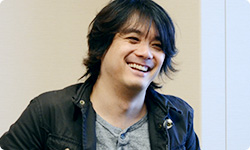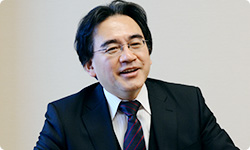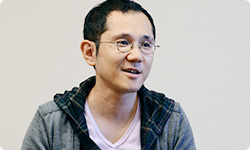In terms of the make-up of the team who produced this title, how were various duties shared among staff members from LEVEL-5 and Capcom?
Broadly speaking, LEVEL-5 was responsible for the programming, while Capcom were in charge of art direction. Both companies were responsible for parts of the story and the music.
Oh my! The usual arrangement is that one party takes the overall lead. I find it interesting that you worked on the story and music together.
The music for the Professor Layton part and the Ace Attorney part were created separately, but there were crossovers too, as both teams used what they could from each other’s compositions.
Another issue we had to deal with was the fact that the programmers were working in LEVEL-5’s head office in Fukuoka, so we had a number of meetings between Tokyo, Osaka and Fukuoka. There were quite a few clashes, weren’t there, Takumi-san?
Yes, there were.
What kinds of things did you clash most fiercely about? Were there matters on which both parties would refuse to budge?
As you might imagine, we both felt strongly about the characters. There was quite a conflict about Layton’s graphics, for example.
When I was shown some images from the game, I did think they looked more familiar than I expected. I don’t suppose it was just a case of taking the characters from both series and lining them up next to each other, though. There must have been an awful lot of hard and painful work involved in getting things looking as they do now?
There were certainly some pretty painful moments! (laughs) Characters’ heads and bodies would be made bigger, then smaller again...
It sounds like there were a lot of adjustments.
If I may say so, I think Professor Layton was adjusted to match Ace Attorney’s style! (laughs)
(laugh)

Layton is actually about four or five heads tall, but in this game he’s quite a lot bigger.
Actually, when I look at the original Layton series now, I do get a feeling there’s something different about him...
Hearing that makes me feel a little uneasy... (laughs)
Well, it’s because I’ve been looking at the Layton from this game for two years straight now! (laughs) Of course, it stands to reason that people who have created an original character are rather particular about it. There were quite a few disagreements, with LEVEL-5 staff telling Capcom designers that they wouldn’t budge when it came to Professor Layton. But we took our time and searched for things we agreed on. That’s how we ended up with the Layton that we have now.
I think that’s really the foundation of creativity. To give an unrelated example, we have a tacit understanding that Professor Layton doesn’t show the inside of his hat. We’re always careful to fix animated scenes to make sure this doesn’t happen. The process of creating new art involves putting a lot of time and effort into the details.
The characters from two companies were given equal importance in the game, and so neither company was able to decide things unilaterally. It must have been really difficult when there were things you wouldn’t budge on.
Yes. We also had some difficulty with the graphics for the city where the game is set. We’d said at the start that it should have a “medieval” feel, but coming up with a specific definition of what this meant was not easy. I was worried about how we were going to distinguish between the fantastical London that appears in the original Layton games and Labyrinthia, the parallel world from this game. In the end, I think we managed to strike a delicate balance between keeping things realistic, to a certain extent, while adding elements of the fantastical here and there.
When I look at the finished product, it’s a world that immediately draws me in, because it seems totally natural.
It makes me happy to hear you say that. Sometimes when you’ve been working on something and looking at it for a long time, it’s inevitable you sometimes become unable to make objective judgements about it.
How about the characters which inhabit the city? Did they tend to be influenced more by one of the original game worlds than the other?
In the end, I think each character was made with either one of the game worlds in mind. We had the idea of introducing a new touch, but we thought that if players got the feeling they’d never seen these characters before, it would rather weaken the sense that this title was two game worlds coming together...
That’s really strange. I didn’t get the impression that the character designs were biased towards one of the game worlds over the other.
Well, when you look closely at the individual characters, they do have elements that reveal which game world their designer had in mind. Having said that, I think they all co-exist happily.
They’re all mixed up together, then?
Yes, they’re mixed up together, in a nice way, but they also lead separate lives. Having said that, the new heroine from this title, Espella 15, is totally from the Ace Attorney side.15. Espella: a young woman who lives in Labyrinthia. After coming to London to seek Professor Layton’s help, she is accused of witchcraft and asks Phoenix Wright to defend her in court.
She certainly does look like that, I suppose. (laughs)
Also, some of the characters who appear during the trials have very interesting-looking outlines. I think that many of them actually give the feeling that they were formed from a fusion of Professor Layton and Ace Attorney.
I suppose that this variety is the reason why the game doesn’t seem to draw too heavily on either of the two series. It must be very difficult to get the balance right, though.

It really is. Just talking about it now made me think all over again how difficult it was. Though I think it was the art director who had to work hardest.
(laugh)
The visuals weren’t the only issue, though. We also had to try and fuse together both series’ system sounds. There was a lot of trial and error involved with that. I was actually pretty surprised by Takumi-san’s obsession with the voices.
Really?
At the first recording session, we spent two hours just recording short lines like “Objection!” or “Hold it!” over and over again. Even the people who were just watching the sessions were getting nervous! (laughs)
Well, the original voices for Ace Attorney were performed by us, the development staff. We’d record a line 30 or 40 times and choose the best one. I probably approached these sessions with the same sensibility. I’m sorry about that...
So you requested the same number of readings from professional actors? That certainly would take a long time... (laughs)
It did. But we knew that bringing together two different games from two different companies meant this was always going to be a title that took a long time, because of things like that.
It seems you accepted from the beginning that making such a title would present tremendous challenges, including “things like that”, Hino-san! (laughs) I suppose from your point of view, working on this game was a dream come true, and you must have thought there was no point in doing it if nothing new was going to come of it.
That’s right.
Speaking of new things, this was the first time the Capcom staff had had to take on challenges like bringing the previously 2D characters of Ace Attorney into 3D, or creating animated scenes. We therefore spent quite a long time just researching how Phoenix could be represented in 3D.
When you look at the character you’ve created, though, and the way he moves so smoothly, he could never go back to being a purely 2D creation any more. He’s too charming.
That’s right. One of the things we tried to do in particular this time was use parallax 3D to recreate the oppressive atmosphere of the courtroom and make the player feel like they’re really there. Even as one of the people who created the game, when I play those scenes I am kind of moved. I really think the courtroom scenes have a kind of intensity that makes the player feel like they’re there. As I worked on this title I realised for the first time that this game had a close affinity with Nintendo 3DS, and I feel very fortunate in that regard.
So you actually made some discoveries that could be considered necessary, or crucial, after you started working on the project?
That’s right. Another thing I’m personally very fond of is the cityscape we created. I feel the stereoscopic 3D gives it a real depth. We really like stereoscopic 3D, so we got quite passionate about making constant adjustments that would make it look even better. I really hope that players enjoy the 3D graphics in this game.
It seems that using stereoscopic 3D allowed you to create a fresh, vivid world that feels like it really exists.
You know, I feel that, in a number of senses, we’ve created something epic.
It’s certainly an epic in terms of volume too. The producer on the Capcom side said that you could play this game forever and never be done with it. He meant that in a good way, of course.
How many hours of gameplay do you think this title contains?
I heard just now that he’s played for 27 hours so far. It seems that if you play properly, there’s 30 hours of gameplay there.

That’s quite exceptional for a game of this genre.
In the second half of the story, at the point when the overall objective of the game becomes clear, I thought it might have been too much. But I also felt that, having gone that far, I couldn’t turn back, and so I pushed through to the end!
(laugh)
© 2024 Nintendo.